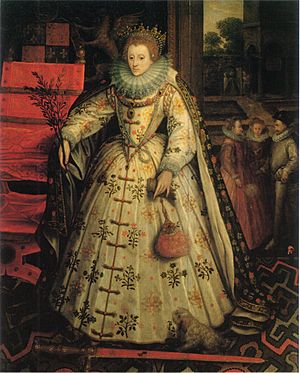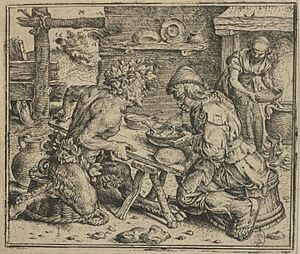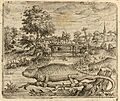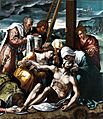Marcus Gheeraerts the Elder facts for kids
Marcus Gheeraerts the Elder (around 1520 – around 1590) was a talented artist from Flanders (which is now part of Belgium). He was a painter, a draughtsman (someone who makes drawings), a print designer, and an etcher. He worked in his home country and later in England.
Gheeraerts created many different types of art, including portraits (pictures of people), religious paintings, and landscapes. He also designed decorations for tombs and coats of arms. He is famous for making a detailed map of his hometown, Bruges, and for illustrating a Dutch book of Aesop's Fables. His careful attention to natural details, especially when drawing animals, greatly influenced how books were illustrated across Europe. His son, Marcus Gheeraerts the Younger, also became a well-known painter for the English royal court.
Contents
Life Story
Marcus Gheeraerts the Elder was born in Bruges, Flanders. His father, Egbert Gheeraerts, was also a painter. Marcus was born between 1516 and 1521. After his father died, his mother married another painter named Simon Pieters. Marcus grew up with six half-siblings, which is why he was sometimes called Marcus Pieters.
We don't know who taught Marcus Gheeraerts to paint. He probably started learning from his stepfather, Simon Pieters. He might have also trained with other artists, possibly outside Bruges, to learn etching, a special way of making prints.
Marcus became a master painter in Bruges in 1558. This meant he was a recognized artist. He quickly became an important member of the local artists' guild.
In 1558, Marcus married Johanna Struve. They had three children, including his famous son, Marcus the Younger.
Artistic Projects in Bruges
Marcus Gheeraerts was very busy as an artist in Bruges. He designed heraldic symbols (like family crests). In 1559, he was asked to design decorations for the tombs of important historical figures, Mary of Burgundy and Charles the Bold.
In 1561, he finished a large painting called the "Passion of Christ" that another famous painter, Bernard van Orley, had started many years before. This painting was eventually placed in the Church of Our Lady in Bruges.
Gheeraerts also created a large, detailed map of Bruges in 1561. It was one of the first maps to show a city accurately from a bird's-eye view. During this time, he likely painted the "Triumphant Christ," which is now in the Memling Museum in Bruges.
Moving to England
Marcus Gheeraerts became involved with a religious group called the Calvinists in Bruges. At first, their religion was tolerated, but then a new governor arrived in 1567, and Calvinists faced persecution. Gheeraerts participated in protests and used his art to comment on the religious changes of his time. He created a print called the Allegory of Iconoclasm, which showed his feelings about the destruction of religious art during this period.
Because of his strong views and some prints he made, Gheeraerts faced legal trouble. Fearing for his life, he fled to England in 1568 with his son Marcus. His wife and daughter stayed behind in Bruges. He was found guilty in his absence and lost all his property.
In London, Gheeraerts started a new life. His daughter joined him in 1571 after her mother passed away. Marcus then married Sussanah de Critz, whose brother was a painter for Queen Elizabeth I. Marcus and Sussanah had two daughters and one son.
In England, Gheeraerts continued to draw, etch, and paint. Since there was a high demand for portraits, he began painting them, which was a new type of art for him.
Historians are not sure if Gheeraerts returned to Flanders around 1577. He might have registered with an artists' guild in Antwerp to work with printers there, or he might have actually lived and worked in Antwerp for a time.
Marcus Gheeraerts had several students, including his son, Marcus the Younger. His son likely learned from him and other Flemish artists who had also moved to England. Marcus Gheeraerts the Elder passed away sometime before 1599.
His Artworks
What He Created
Marcus Gheeraerts was a versatile artist. He was a painter, a draughtsman, a print designer, an etcher, and an ornamental designer. Many of his paintings were lost during the religious conflicts of the 16th century. Because of this, he is mostly known today for his prints and print designs. He was also an innovator, experimenting with etching when other techniques like woodcut were more common. For example, his large map of Bruges from 1562 was made using 10 etched plates.
Paintings by Gheeraerts
It's hard to be completely sure which paintings were made by Gheeraerts because he didn't sign them. However, we know he finished the "Passion of Christ" triptych started by Bernard van Orley. This painting was later damaged and repainted by another artist, Frans Pourbus the Younger.
The painting "Triumphant Christ" in the Memling Museum in Bruges is believed to be by Marcus Gheeraerts. Another painting, "Lazarus and the rich man," is also thought to be his, but some experts disagree.
Gheeraerts was known for painting portraits. The famous "Portrait of Queen Elizabeth I," also called the Peace portrait, is often linked to him. However, it has a monogram that could belong to either Marcus the Elder or his son, Marcus the Younger. Some art historians think it was a collaboration between father and son. A portrait of Prince William I of Orange is also attributed to him.
Two paintings showing celebrations, the Fête at Bermondsey and A village festival, were once thought to be by another artist. But in 2015, they were attributed to Marcus Gheeraerts the Elder. The Fête painting shows people in different European fashions, as requested by the person who ordered it. Both paintings likely show marriage celebrations and feature members of the Flemish community in England.
Gheeraerts' painting style was first influenced by Bernard van Orley. Later, he adopted the Italian style of painting seen in the works of Maerten de Vos.
His Prints
Gheeraerts made many prints and designed them both in Flanders and England. His most famous print works before he left for England include the map of Bruges and the Allegory of Iconoclasm (which we talked about earlier). He also created illustrations for an important book of fables called De warachtighe fabulen der dieren.
The True Fables of the Animals
This book was published in 1567 in Bruges. Marcus Gheeraerts etched the title page and 107 illustrations for the fables written by his friend, Edewaerd de Dene. Gheeraerts actually started and paid for the book's publication. It was a very fancy book for its time, printed with high quality.
Each fable in the book took up two pages. On the left, there was an illustration with a proverb and some verse. On the right, the fable itself and its moral lesson were told. This was the first book of its kind to combine fables with emblems (pictures with symbolic meanings), and it became very popular, setting a trend for similar books.
Gheeraerts added more illustrations for a French version of the book published in 1578, and a Latin version came out the next year. His copper plates (used for printing) were used in books for a long time, even into the 18th century. His fable illustrations were copied by artists all over Europe. He also etched another series of illustrations for a different fable book, Apologi Creaturarum, published in 1584.
Images for kids







